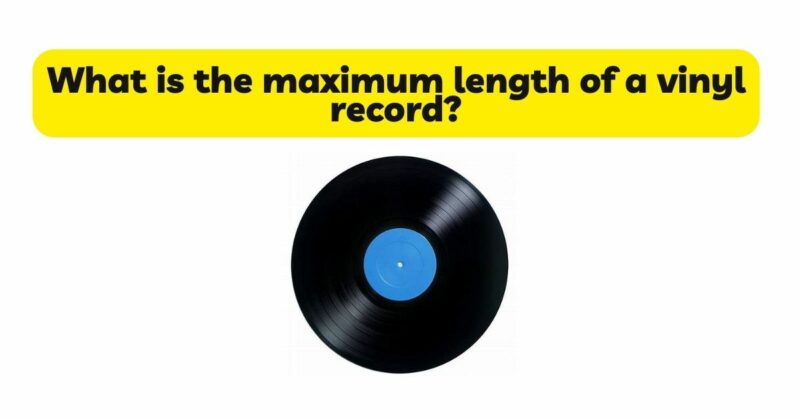Vinyl records have long been revered for their unique sound and tactile experience. However, the physical limitations of the medium impose constraints on the length of music that can be accommodated on a single vinyl record. In this article, we will explore the maximum length of a vinyl record, the factors influencing this limit, and the implications for artists, albums, and the listening experience. By understanding the constraints and possibilities, we can gain insights into the creative and technical considerations of vinyl record production.
- Basic Vinyl Record Format: Vinyl records are typically available in three primary formats: 7-inch, 10-inch, and 12-inch. The diameter of the record directly influences its playing time capacity. Let’s examine the maximum length for each format:
a. 7-inch: A standard 7-inch vinyl record, commonly referred to as a single, can hold approximately 4-7 minutes of music per side. This limited playing time makes it suitable for singles, EPs, or shorter tracks.
b. 10-inch: A 10-inch vinyl record offers slightly more playing time compared to a 7-inch record. It can accommodate approximately 8-15 minutes of music per side, making it suitable for extended play releases or mini-albums.
c. 12-inch: A 12-inch vinyl record, the most common format for full-length albums, can hold around 18-22 minutes of music per side. This longer playing time allows for the inclusion of more tracks and longer compositions.
- Groove Spacing and Sound Quality: The maximum length of a vinyl record is determined by the physical size of the disc and the spacing of the grooves. Consider the following factors:
a. Groove Width and Spacing: The grooves on a vinyl record carry the audio information, and the width and spacing of these grooves directly affect the playing time. Wider grooves allow for more audio information, while narrower grooves limit the available space.
b. Sound Quality Considerations: To maintain optimal sound quality, it is crucial to strike a balance between groove spacing and sound fidelity. Crowding too much audio information into a limited space can result in compromised sound quality, increased surface noise, and reduced dynamic range.
- Recording Density and Audio Quality: The audio quality and desired fidelity also impact the maximum length of a vinyl record. Consider the following aspects:
a. Recording Density: The recording density refers to the amount of audio information packed into the grooves. Higher recording density allows for more music to be stored on a record, but it can also increase the risk of audio degradation and reduced playback quality.
b. Dynamic Range and Audio Fidelity: Vinyl records are known for their warm and dynamic sound. However, to maintain the desired audio fidelity and dynamic range, it is essential to avoid excessive compression or limiting during the mastering process. Compression can affect the overall playback time and compromise sound quality.
- Record Speed: The record speed, typically 33 1/3 revolutions per minute (RPM) or 45 RPM, also influences the maximum playing time. The higher the record speed, the more audio information can be accommodated within a given length of the grooves. However, higher speeds can result in reduced playback time due to faster rotation.
- Vinyl Record Double LPs: To accommodate longer albums or extended compositions, artists and labels often release double LPs. A double LP consists of two vinyl records, allowing for extended playing time. By spreading the audio content across multiple discs, artists can maintain sound quality and provide a more immersive listening experience.
- Technological Advances: Technological advancements in vinyl record production have allowed for increased playing time and improved audio quality. For example, microgroove technology and finer stylus tips have enabled records to accommodate more audio information within a given space, expanding the maximum playing time.
- Creative Considerations: Artists and producers must consider the limitations and possibilities of vinyl when designing their albums. The physical constraints of vinyl records can influence artistic decisions regarding track selection, sequencing, and overall album length. Some artists choose to embrace the limitations of vinyl, crafting concise and cohesive experiences that align with the medium’s unique characteristics.
- Digital and Streaming Formats: With the advent of digital and streaming formats, artists have the freedom to release longer compositions without the constraints of vinyl. Longer albums or extended tracks can be distributed digitally, while vinyl records can focus on a curated selection of tracks or a specific sonic experience.
Conclusion: Vinyl records have a maximum length determined by the physical size of the disc, groove spacing, and desired audio fidelity. The length varies based on the record format (7-inch, 10-inch, or 12-inch) and the available groove space. Factors such as recording density, dynamic range, and record speed also influence the maximum playing time. Artists and labels often utilize double LPs to accommodate longer albums, while technological advancements have expanded the possibilities for longer playing times. Understanding the limitations and creative considerations of vinyl records enables artists, producers, and collectors to make informed decisions about track selection, sequencing, and album length. By embracing the unique characteristics of vinyl, artists can create immersive listening experiences that celebrate the medium’s warm sound and tactile appeal.

